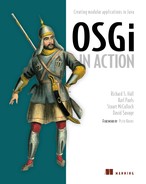Appendix B. OSGi standard services
This appendix lists the Core, Compendium, and Enterprise services defined in release 4.2 of the OSGi specification. All services are optional: some are available from framework vendors, others are available from third-party vendors. Most service implementations work with any OSGi R4 framework.
B.1. Core OSGi services
Table B.1 lists the services defined in the OSGi Core specification. All of them are optional singleton services provided by the framework, except for the Service Hooks which may have zero or more instances registered by other bundles.
Table B.1. Core OSGi services
|
Name |
Description |
Package |
Version |
|---|---|---|---|
| Package Admin | Provides the ability to control and reflect over bundle- and package-level wiring | org.osgi.service.packageadmin | 1.2 |
| Start Level | Controls the relative order of bundle startup by assigning start levels to bundles | org.osgi.service.startlevel | 1.1 |
| Conditional Permission Admin | Enables permission assignment to bundles based on arbitrary conditions | org.osgi.service.condpermadmin | 1.1 |
| Permission Admin | Enables permission assignment to bundles based on bundle location | org.osgi.service.permissionadmin | 1.2 |
| URL Handlers | Multiplexes URL and content-handler factories to allow bundles to provide custom handlers | org.osgi.service.url | 1.0 |
| Service Hooks | Allows bundles to monitor and limit service registry events and access | org.osgi.framework.hooks.service | 1.0 |
B.2. Compendium OSGi services
Table B.2 lists the services defined in the OSGi Compendium specification. These services are provided by optional bundles installed on the base OSGi framework. There can be zero or more versions of a service registered at the same time.
Table B.2. Compendium OSGi services
B.3. Enterprise OSGi services
Table B.3 lists the services defined in the OSGi Enterprise specification and specifically relating to using OSGi in an enterprise environment. These services are provided by optional bundles installed on the base OSGi framework. There can be zero or more versions of a service registered at the same time.
Table B.3. Enterprise OSGi services
|
Name |
Description |
Package |
Version |
|---|---|---|---|
| Remote Service Admin | Addresses how remote services can be provided inside an OSGi framework and discovered in a network | org.osgi.service.remoteserviceadmin | 1.0 |
| JTA | Provides the JTA specification as a service-based model | javax.transaction | 1.1 |
| JMX | Exposes an OSGi framework via JMX | org.osgi.jmx | 1.0 |
| JDBC | Enables OSGi-aware JDBC drivers | org.osgi.service.jdbc | 1.0 |
| JNDI | Defines how JNDI can be utilized from within an OSGi framework | org.osgi.service.jndi | 1.0 |
| JPA | Specifies how persistence units and JPA providers work in an OSGi framework | org.osgi.service.jpa | 1.0 |
